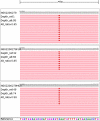A case of Aicardi-Goutières syndrome caused by TREX1 gene mutation
- PMID: 36814213
- PMCID: PMC9945611
- DOI: 10.1186/s12884-023-05436-5
A case of Aicardi-Goutières syndrome caused by TREX1 gene mutation
Abstract
Aicardi-Goutières syndrome (AGS) is a rare genetic disorder involving the central nervous system and autoimmune abnormalities, leading to severe intellectual and physical disability with poor prognosis. AGS has a phenotype similar to intrauterine viral infection, which often leads to delays in genetic counseling. In this study, we report a case with a prenatal diagnosis of AGS. The first fetal ultrasound detected bilateral lateral ventricle cystic structures, and fetal MRI was performed to identify other signs. The right parietal lobe signal showed cerebral white matter abnormalities, and fetal brain development level was lower than that of normal fetuses of the same gestational age. Whole-exome sequencing revealed that the fetus carried the TREX1:NM_033629.6:exon2:c.294dup:p. C99Mfs*3 variant, suggesting that the c.294dup mutation of the TREX1 gene was the pathogenic mutation site, and the final comprehensive diagnosis was AGS1. In this article, we also reviewed the previous literature for possible phenotypes in the fetus and found that microcephaly and intrauterine growth retardation may be the first and most important markers of the intrauterine phenotype of AGS.
Keywords: Aicardi-Goutières syndrome; Autoimmune diseases of the nervous system; Microcephaly; Nervous system malformations; Prenatal diagnosis; TREX1; Whole-exome genome sequencing.
© 2023. The Author(s).
Conflict of interest statement
The authors declare no competing interests.
Figures



Similar articles
-
[Clinical and genetic analysis of a family with Aicardi-Goutières syndrome and literature review].Zhonghua Er Ke Za Zhi. 2014 Nov;52(11):822-7. Zhonghua Er Ke Za Zhi. 2014. PMID: 25582466 Review. Chinese.
-
Phenotypic variability of a TREX1 variant in Aicardi-Goutieres type 1 patients from the Indian subcontinent.Eur J Med Genet. 2021 Sep;64(9):104291. doi: 10.1016/j.ejmg.2021.104291. Epub 2021 Jul 22. Eur J Med Genet. 2021. PMID: 34303877
-
Neuropathological Findings in a Case of IFIH1-Related Aicardi-Goutières Syndrome.Pediatr Dev Pathol. 2019 Nov-Dec;22(6):566-570. doi: 10.1177/1093526619837797. Epub 2019 Apr 5. Pediatr Dev Pathol. 2019. PMID: 30952201 Free PMC article.
-
A nationwide survey of Aicardi-Goutières syndrome patients identifies a strong association between dominant TREX1 mutations and chilblain lesions: Japanese cohort study.Rheumatology (Oxford). 2014 Mar;53(3):448-58. doi: 10.1093/rheumatology/ket372. Epub 2013 Dec 3. Rheumatology (Oxford). 2014. PMID: 24300241
-
Aicardi-Goutières syndrome.Handb Clin Neurol. 2013;113:1629-35. doi: 10.1016/B978-0-444-59565-2.00031-9. Handb Clin Neurol. 2013. PMID: 23622384 Review.
Cited by
-
Diagnostic yield of trio exome sequencing as a first-tier test for identifying genetic causes of pregnancy loss.J Hum Genet. 2025 Jul 24. doi: 10.1038/s10038-025-01373-7. Online ahead of print. J Hum Genet. 2025. PMID: 40702308
-
Prevalence and impact of molecular variation in the three-prime repair exonuclease 1 TREX1 and its implications for oncology.Hum Genomics. 2025 Jun 28;19(1):73. doi: 10.1186/s40246-025-00785-y. Hum Genomics. 2025. PMID: 40581636 Free PMC article.
References
-
- Crow YJ, Chase DS, Lowenstein Schmidt J, Szynkiewicz M, Forte GMA, Gornall HL, et al. Characterization of human disease phenotypes associated with mutations in TREX1, RNASEH2A, RNASEH2B, RNASEH2C, SAMHD1, ADAR, and IFIH1. Am J Med Genet Part A. 2015;167:296–312. doi: 10.1002/ajmg.a.36887. - DOI - PMC - PubMed
Publication types
MeSH terms
Substances
Supplementary concepts
Grants and funding
- ChiCTR-SOC-17010976/Chinese Multi-center Clinical Research
- GSKY20210232/Scientific Program from Gusu School,Nanjing Medical University
- GSWS2019006/Suzhou Gusu Health Talents Program
- F202044/Jiangsu Provincial Maternal and Child Health Scientific Project
- KJXW2021032/Suzhou "Rejuvenating Health through Science and Education" Youth Science Project
LinkOut - more resources
Full Text Sources
Medical
Research Materials
Miscellaneous

